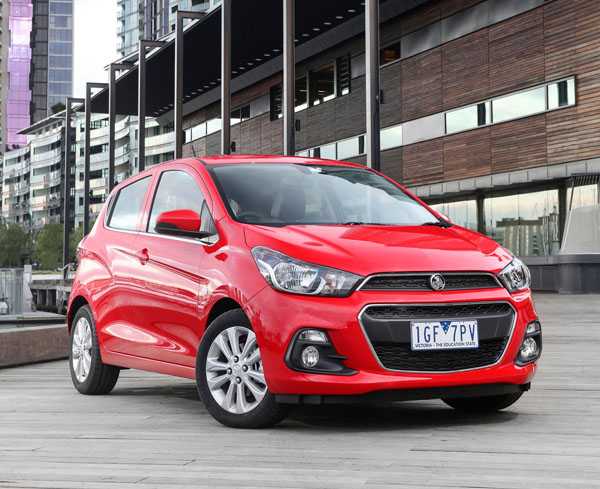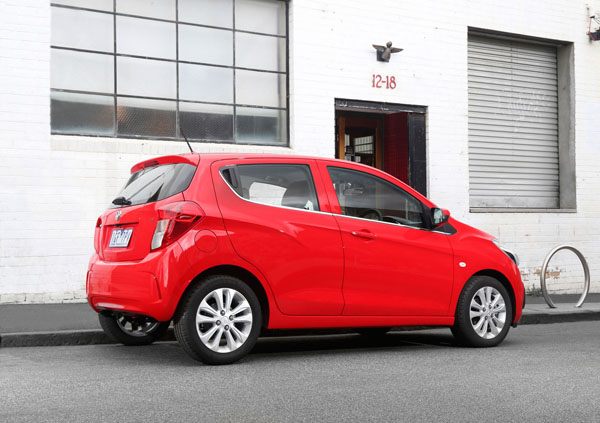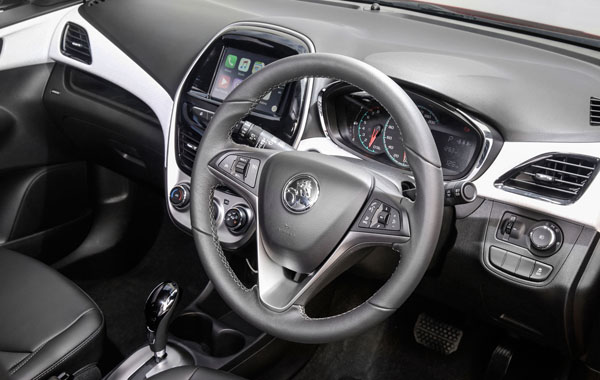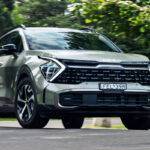Major Holden engineering input in the new Spark included the tuning of steering and suspension, and the continuously variable automatic transmission specifically designed for Australian conditions.
A stronger body has enabled engineers to tune ride and handling more precisely, for a greater feeling of control and refinement, also engendering a quieter ride. This was achieved during thousands of kilometres over months of extensive work at Holden’s Lang Lang proving ground and on public roads.
On top of that, the new model incorporates Apple CarPlay and Android Auto connectivity across the range, all for a starting price of less than $14,000, plus on-road costs. On test was the top-of-the-range Spark LT automatic, which can be had for $18,990, plus on-roads.
STYLING
New Holden Spark is sharper looking than the car it replaces and, thanks to a slightly longer wheelbase and a trim in height of about 40 mm, aerodynamic drag has been reduced, helping improve fuel efficiency.
Michael Simcoe, Vice-President of GMI Design says the new Spark stands out with a sleeker proportion and more sophisticated aesthetics. “With a lower roof height, thinner pillars and a more efficient package, where the wheels are pushed to the edges of the fenders, the car now has a more substantial, firmly planted presence.”
INTERIOR
Inside, designers have matched the lowered roof height by adjusting the hip-point dimensions for the seats, maintaining the ample headroom of the superseded model and offering comparable spaciousness, together with improvements to the driving position.
Upgraded materials and greater attention to detail, including everything from the higher-quality fabrics to higher-density seat foam that enhance comfort and durability, add to comfort.
INFOTAINMENT
With the latest communication technology high on the list of car buyers’ wish lists these days, the Spark is well kitted out. The Holden MyLink infotainment system, with 7.0-inch colour touchscreen has Apple CarPlay and Android Auto phone projection.
Siri Eyes Free and smartphone voice recognition software also allow drivers to give verbal commands so that, hopefully, their hands never leave the wheel.
ENGINES / TRANSMISSIONS
The new 1.4-litre four-cylinder engine serves up maximum power of 73 kW and peak torque of 128 Nm, which during numerous trips to South Korea by Holden engineers was matched with a continuously variable transmission to suit Australian conditions.
The result is a 16 per cent increase in power and up to a 20 per cent more torque, together with noise and vibration improvements. Holden claims fuel consumption of 5.5 litres per 100 kilometres on the combined urban / highway cycle.
SAFETY
Key to Spark’s maximum five-star safety rating is a number of key features including driver assistance controls such as electronic stability control, traction control and anti-lock braking; front, side and curtain airbags. There’s a rearview camera with park assist on the higher-spec LT model.
Another important attribute is a high-strength steel safety cage capable of supporting a roof-load 3.92 times that of its own weight – a total of just under 3.9 tonnes, the weight of the Queensland and New South Wales State of Origin rugby league squads combined.
DRIVING
As well as many hours and kilometres of tuning and calibration work, Holden engineers selected 29 young employees and student interns to test two Sparks continuously over a three-month period.
While giving the thumbs-up to the ride and handling, the group was more focused on how connectivity and convenience features integrated with their everyday lives.
The result is a comfortable, easy-to-handle vehicle with a level of technological tie-ups normally found only in vehicles of a more premium nature. Friends and family are never far from the car.
However, for all its wizardry, there is no getting away from the fact that this is a small vehicle, especially when it comes to a full complement of occupants and the need to carry their gear. The cargo area is tiny (185 litres). Also, initially confusing are the rear doors with concealed handles.
Headroom is impressive, while shoulder space remains adequate; legroom in the back is limited for the taller person, and seats all round are firm and could be trying on a long run.
SUMMING UP
The Spark LT is only a cheapish car that on price is closing in on rivals in the segment above. Where Spark does shine is in its ability, via the latest technology, to become a big part of the owner’s lifestyle through connectivity with the outside world.
AT A GLANCE
MODEL RANGE
Holden Spark LS manual $13,990 Holden Spark LS automatic $15,690
Holden Spark LT automatic $18,990
Note: These prices do not include government or dealer delivery charges. Contact your local Holden dealer for drive-away prices.
FEATURES (Spark LT)
1.4-litre engine
CVT transmission
15-inch alloy wheels
Electronic stability control
ABS & traction control
Hill start assist
Remote central locking
Electric power steering
60/40 rear folding seats
Driver information cluster
Leather-look upholstery
Steering wheel audio controls Leather wrapped steering wheel
Keyless entry
Rear park assist
Rear view camera
Cruise control
Holden MyLink infotainment system with 7-inch colour touch screen
Apple CarPlay and Android Auto mobile phone projection
Siri Eyes Free and Smartphone Voice Recognition
USB input
SPECIFICATIONS (Holden Spark LT 1.4-litre five-door hatchback)
ENGINE:
Capacity: 1.398 litres
Configuration: Four cylinders in line
Maximum Power: 73 kW
Maximum Torque: 128 Nm
Fuel Type: Petrol 91 RON
Fuel tank capacity 32 litres
DRIVELINE: Continuously variable automatic transmission
DIMENSIONS:
Length: 3596 mm
Wheelbase: 2385 mm
Width: 1595 mm
Cargo capacity: 185 litres (rear backs raised); 985 litres (backs folded)
BRAKES:
Front: Disc
Rear: Drum
STANDARD WARRANTY:
Five years / 100,000 km
First there was the Barina; then Barina Spark; now comes the Spark. Holden’s micro-car has come a long way, both in name and development, the latter much of at the hands of Australian engineers.












